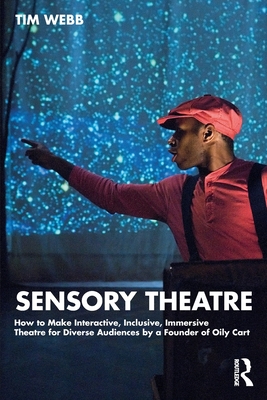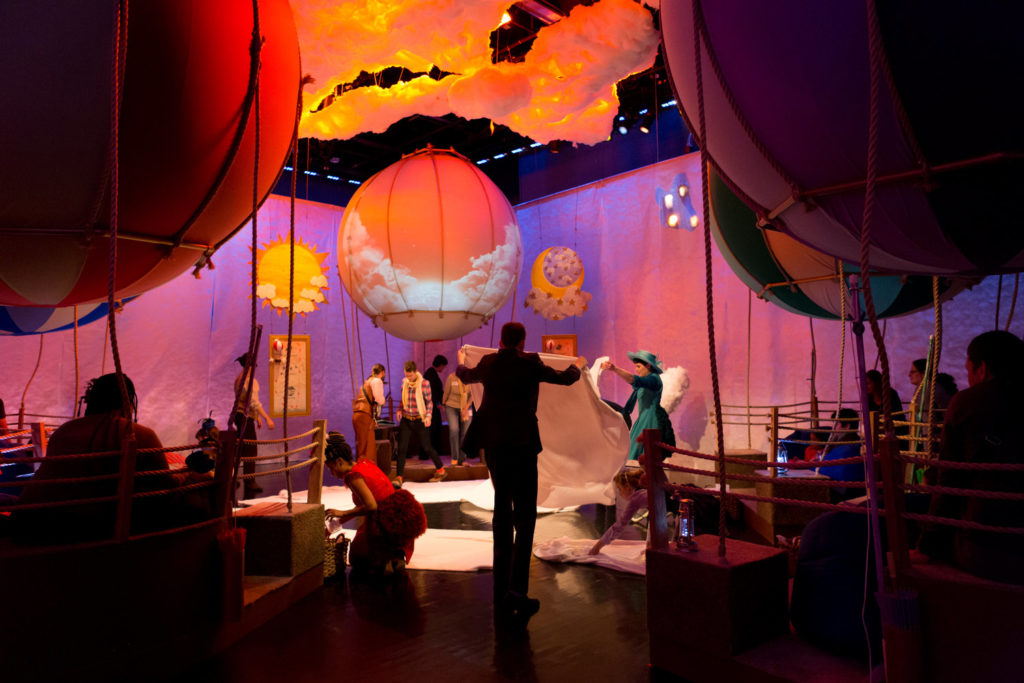This review is being cross-published both here and at TYA Today Magazine.
Live theatre is unparalleled among art forms because it is alive, immediate, and visceral. It welcomes all and invites people to go on a journey beyond their day-to-day lives. Since the 1980s, Tim Webb and the U.K.-based Oily Cart company have sought to create theatre for audience members with disabilities, and to do so in a way that is interactive, immersive, and inclusive. Many have drawn from and expanded upon this work through observation, practice, and mentorship from Tim. Now there is a groundbreaking book that opens the doors to all theatre practitioners to create performances, especially for the very young and for neurodivergent audiences, including those on the autism spectrum. The process, purpose, and practical requirements for this kind of work are given with rich examples in Webb’s new book, Sensory Theatre: How to Make Interactive, Inclusive, and Immersive Theatre for Diverse Audiences by a Founder of Oily Cart.

The book covers sensory theatre intended for two different audiences: The first is a TVY (Theatre for the Very Young) audience of children under 5 years old. The second focuses on those with PMLD (Profound and Multiple Learning Disabilities) and audiences with autism. PMLD is a British term for any disability that disrupts the typical flow of information to a person through one or more senses; it can include impairments of vision or hearing, dependence upon a wheelchair or tube feeding, or neurodivergence that includes cerebral palsy and host of other conditions. Some folks with PMLD struggle with memory, which makes a traditional narrative challenging to retain during the length of a performance. Performances for PMLD audiences and autistic audiences thus require different approaches.
Sensory Theatre is broken down into three sections. The first explores the beginnings of sensory theatre. In some ways this is a journey through the origins of Oily Cart, as productions are shared with lessons and principles that can be drawn to make sensory theatre successful. Chapters address such topics as location, duration, and style of performance to more deeply understanding the needs of sensory theatre’s target audience.
The second section is a practical how-to guide of what it takes to develop and devise a piece of sensory theatre. Several chapters are devoted to deep dives into each sense, and practical understandings of how a production might use any of the five basic senses, as well as considerations for some of sensory theatre’s hallmarks, such as kinesthetic movement. For those unfamiliar with the work of Oily Cart and Sensory Theatre, many of these productions are aimed at small audiences, sometimes with a one-to-one ratio of performers to audience members, who are given experiences they may not normally receive in a theatre performance, such as the feeling of swinging in hammocks, swimming in hydropools, and so forth. There are further chapters outlining needs for casting, directing, rehearsing, and performing sensory theatre.

Oily Cart’s “All Wrapped Up,” 2019.


I particularly loved the chapter about “Wonderlands,” which focuses on imagining and creating awe-inspiring interactive environments for sensory theatre productions. At their core, sensory theatre wonderlands are beautiful and enchanting ways for audiences to more fully engage with a production. The text describes ways to consider making sensory theatre a 360-degree experience that envelops audience members with things to see, smell, feel, hear, touch, and even taste. Creating a wonderland requires considering how audiences are prepared to arrive, where and how they sit, and how to guide guests through the experience. The chapter gives powerful insight into the importance of designing technical elements that are at the peak of production value, as well as being practical and immersive.

The third section is an overview of Sensory Theatre companies across the globe, including highlights such as Trusty Sidekick (co-founded by former TYA/USA executive director Jonathan Shmidt Chapman), which has created sensory theatre for New York City’s Lincoln Center for the Performing Arts. The section includes a breadth of companies and highlights the essential and challenging nature of creating sensory theatre across the globe. There’s also a useful appendix which highlights Oily Cart productions on YouTube and other helpful resources that can serve readers as guideposts for applying the work of sensory theatre wherever they are.
“Theatre needs to change radically,” writes Tim Webb. “It needs to become much more Sensory Theatre, a theatre that is multisensory and interactive, that is directly responsive to the reactions of its audiences, and builds up a relationship with them as individuals.” I’ve been fortunate enough to create this work myself as a University of Central Florida graduate student alongside Tim, and to discuss it with him on my podcast (PodcastTYA). Making theatre a more inclusive place demands radical change, and Sensory Theatre is a foundational text for changing the landscape of TYA productions, and theatre on the whole.
Scott Savage (he/him) is a middle school theatre teacher in Salt Lake City.


